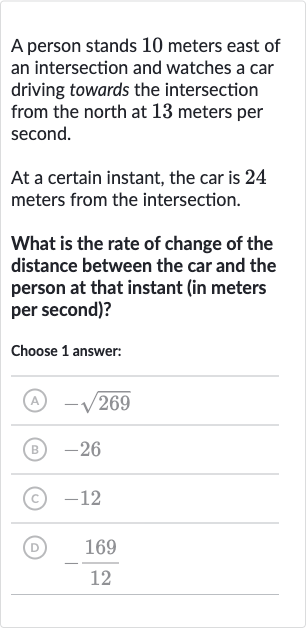AI tutor
Welcome to Bytelearn!
Let’s check out your problem:

A person stands meters east of an intersection and watches a car driving towards the intersection from the north at meters per second.At a certain instant, the car is meters from the intersection.What is the rate of change of the distance between the car and the person at that instant (in meters per second)?Choose answer:(A) (B) (C) (D)
Full solution
Q. A person stands meters east of an intersection and watches a car driving towards the intersection from the north at meters per second.At a certain instant, the car is meters from the intersection.What is the rate of change of the distance between the car and the person at that instant (in meters per second)?Choose answer:(A) (B) (C) (D)
- Draw Triangle: First, let's draw a right triangle where the car is one vertex, the person is the second vertex, and the intersection is the third vertex. The car is meters from the intersection (north side), and the person is meters from the intersection (east side).
- Find Hypotenuse: We need to find the hypotenuse of the triangle, which represents the distance between the car and the person at that instant. We use the Pythagorean theorem: , where is meters, is meters, and is the hypotenuse.
- Calculate Hypotenuse: Calculating the hypotenuse: , so meters.
- Find Rate of Change: Now, we need to find the rate of change of this distance. Since the car is moving towards the intersection, the distance between the car and the person is decreasing. We'll use related rates from calculus. Let's call the distance between the car and the person '', the distance of the car from the intersection '', and the distance of the person from the intersection ''. We have . Since the person is not moving, .
- Use Related Rates: We know meters per second (negative because the distance is decreasing), meters, meters, and meters. Plugging these into the formula: .
- Apply Calculus: Simplifying the equation: meters per second. So, the rate of change of the distance between the car and the person is meters per second.
More problems from Rate of travel: word problems
QuestionGet tutor help
QuestionGet tutor help
QuestionGet tutor help
QuestionGet tutor help
QuestionGet tutor help
QuestionGet tutor help
QuestionGet tutor help
QuestionGet tutor help
